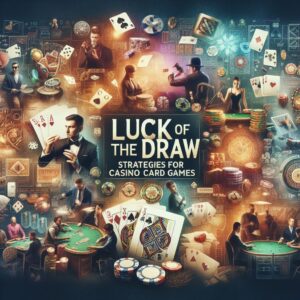
Slot games have long been a staple of the gambling industry, captivating players with their vibrant Spin Cycle, exciting gameplay, and the chance to win big. However, behind the scenes, there is a fascinating lifecycle that every slot game goes through, from inception to release and beyond. In this article, we will explore the various stages of a slot game’s lifecycle, shedding light on the intricate process of creating, developing, and maintaining these popular casino games.
- Conceptualization and Design:
The journey of a slot game begins with an idea or concept. Game developers, in collaboration with creative teams, brainstorm themes, gameplay features, and visual elements that will make the game stand out in a competitive market. The goal is to create an engaging and immersive experience that will resonate with players.
Once the concept is finalized, the design phase begins. Artists and graphic designers work to create captivating visuals, including symbols, backgrounds, and animations that bring the game to life. The design team also collaborates with sound engineers to develop audio elements that complement the gameplay and enhance the overall experience.
- Mathematics and Mechanics:
While the visual and auditory aspects of a slot game are crucial, the underlying mathematics and mechanics play an equally important role. Game developers work closely with mathematicians and statisticians to determine the game’s volatility, Return to Player (RTP) percentage, and the frequency and size of potential wins.
The mathematics behind a slot game ensures that it operates fairly and provides a balanced experience for players. The Random Number Generator (RNG) algorithm is implemented to ensure the outcome of each spin is entirely random, thus maintaining the game’s integrity.
- Development and Testing:
Once the design, mathematics, and mechanics are in place, the development phase begins. Programmers and software engineers use specialized tools and programming languages to bring the slot game to life. They code the game logic, implement the visual and audio assets, and ensure smooth functionality across various platforms and devices.
Throughout the development process, rigorous testing is conducted to identify any bugs, glitches, or inconsistencies in the gameplay. Quality assurance teams meticulously playtest the game, examining every feature and scenario to ensure a seamless and enjoyable experience for players.
- Regulatory Compliance:
Before a slot game can be released to the public, it must adhere to strict regulatory requirements. Depending on the jurisdiction in which the game will be offered, it must undergo certification and testing by independent testing laboratories to ensure fairness and compliance with gambling regulations.
Regulatory compliance involves verifying that the game’s RNG is functioning correctly, confirming that the RTP percentage is accurate, and assessing the game’s adherence to responsible gambling guidelines. This stage is crucial to maintain the transparency and trustworthiness of the slot game.
See Also:



- Release and Distribution:
Once the slot game has successfully passed all the necessary regulatory checks, it is ready for release and distribution. Game developers collaborate with online casino operators, who integrate the game into their platforms. The slot game is made available to players through online casinos, mobile apps, and other digital gambling platforms.
Marketing teams play a vital role in promoting the newly released slot game. They develop effective marketing strategies to generate awareness and attract players. This may involve running advertising campaigns, offering exclusive bonuses or promotions, and leveraging social media platforms to reach a wider audience.
- Player Feedback and Iteration:
After the release, the lifecycle of a slot game enters a phase of continuous improvement and iteration based on player feedback. Game developers value the opinions and experiences of players, as this feedback helps them identify areas for enhancement and refinement.
Player feedback can lead to updates and patches that address issues, improve gameplay mechanics, or introduce new features. Developers may also release expansions or sequels to successful slot games, building on the original concept and incorporating suggestions from the player community.
- Game Longevity and Retention:
Maintaining the longevity and retention of a slot game is a key objective for developers. To keep players engaged and returning to the game, regular updates, new content, and special events are introduced. These may include adding new themes, introducing seasonal promotions, or hosting tournaments and leaderboards to encourage competition among players.
In addition, slot games often offer loyalty programs or reward systems to incentivize player loyalty. These programs may provide access to exclusive bonuses, free spins, or other perks that enhance the player’s experience and encourage continued play.
- Sunset and Legacy:
While many slot games enjoy long and successful lives, there comes a time when some games are retired to make way for new releases. This stage, known as “sunset,” occurs when a game’s popularity wanes or when technological advancements make it obsolete.
However, even in retirement, a slot game can leave a lasting legacy. Some games become iconic within the industry, remembered for their unique features, innovative gameplay, or significant impact on the industry as a whole.
Conclusion: Spin Cycle
The lifecycle of a slot game is a complex and dynamic process that involves the creative efforts of designers, mathematicians, programmers, and various other professionals. From the conceptualization and design stagesto the release, player feedback, and eventual retirement, each phase plays a crucial role in shaping the success and longevity of a slot game.
The journey begins with the conceptualization and design, where the theme, visuals, and audio elements are carefully crafted to create an immersive experience. The mathematics and mechanics are then developed to ensure fairness and balance in the gameplay. Extensive testing and regulatory compliance checks are conducted to ensure the game meets industry standards and regulations.
Once the game is ready for release, marketing efforts are employed to generate awareness and attract players. Player feedback becomes invaluable as developers iterate and improve the game based on player experiences. The game’s longevity is maintained through regular updates, new content, and loyalty programs that keep players engaged and coming back for more.
However, like all things, there comes a time when a slot game may be retired to make way for new releases. Even in retirement, a game can leave a lasting legacy if it has made a significant impact on the industry.
The lifecycle of a slot game is a testament to the creativity, innovation, and collaboration that goes into creating a successful and enjoyable gambling experience. From the initial idea to the final release and beyond, each stage contributes to the evolution and growth of the game. As players continue to seek excitement and entertainment in the world of slot games, developers will continue to push boundaries and create new experiences that captivate and engage players around the world.







